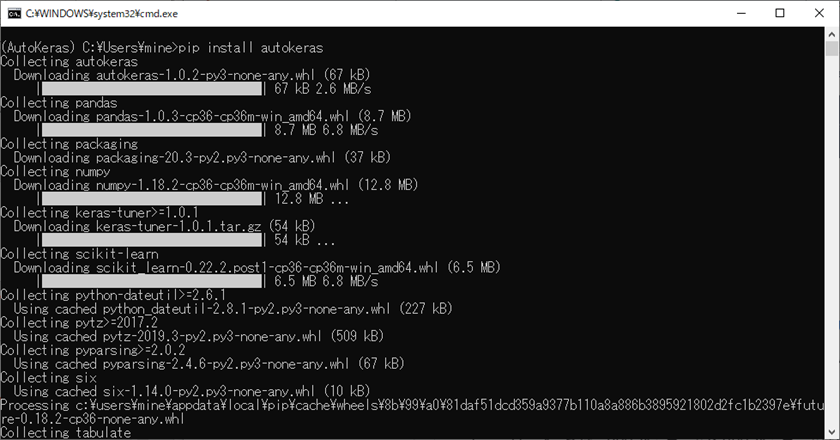機械学習業界では、時代はまさに『AutoML』と言えるような状況ですが、あのKerasにもAutoML対応のフレームワークが出たようです。
※以前からあるようですが、最近新しくなったようです。
AutoKerasとは
AutoKerasとは、テキサスA&M大学のDATA Labで開発された、AutoML対応のKerasモジュールになります。
誰もが機械学習にアクセスできることが目標とのことです。

条件
AutoKerasを動かすための条件は以下のようになっています。
- Python 3.5以上
- TensorFlow 2.1.0以上
以前はPyTorchを呼んでいたらしいのですが、今はTensorFlowベースとなっています。
インストール
AutoKerasのインストールは簡単で、pip一発で終了です。

サンプル
お馴染みのMNISTを実装してみると、以下のようなコードになります。
from tensorflow.keras.datasets import mnist
import autokeras as ak
# Prepare the dataset.
(x_train, y_train), (x_test, y_test) = mnist.load_data()
print(x_train.shape) # (60000, 28, 28)
print(y_train.shape) # (60000,)
print(y_train[:3]) # array([7, 2, 1], dtype=uint8)
# Initialize the ImageClassifier.
clf = ak.ImageClassifier(max_trials=3)
# Search for the best model.
clf.fit(x_train, y_train, epochs=10)
# Evaluate on the testing data.
print('Accuracy: {accuracy}'.format(accuracy=clf.evaluate(x_test, y_test)))
モデルの作成が「ImageClassifier()」という関数だけで終了してしまいます。
これだけでレイヤーの調整やはおぱーパラメータまでいい感じにしてくれるなんて、信じがたいものがあります。
識別機
組み込みの識別機には、以下の6種類が用意されています。
- ImageClassifier(画像分類)
- ImageRegressor (画像回帰)
- TextClassifier (テキスト分類)
- TextRegressor (テキスト回帰)
- StructuredDataClassifier (構造化データ分類)
- StructuredDataRegressor (構造化データ回帰)
[画像, テキスト, 構造化データ]×[分類, 回帰]といった感じです。
なお、汎用的な識別機(AutoModel)も用意されています。
引数として「max_trials」が用意されており、これがモデルの試行回数となります。
多ければ多いほどいろいろなパターンを試せるのですが、当然のことながら激しく時間がかかります。
関数&パラメータ
主な関数として、お馴染みの
- fit()
- predict()
- evaluate()
が用意されています。
「fit()」時に、モデルの試行を行うとともに、指定したエポック数(EarlyStoppingあり)で学習を繰り返します。
また、モデルの試行が終わったところで、結果を以下のように表示します。
Trial complete
Trial summary
|-Trial ID: 7721ba2b2344499c8cc23920528e1976
|-Score: 0.04051450350758387
|-Best step: 0
Hyperparameters:
|-classification_head_1/dropout_rate: 0.5
|-classification_head_1/spatial_reduction_1/reduction_type: flatten
|-dense_block_1/dropout_rate: 0
|-dense_block_1/num_layers: 1
|-dense_block_1/units_0: 128
|-dense_block_1/use_batchnorm: False
|-image_block_1/augment: False
|-image_block_1/block_type: vanilla
|-image_block_1/conv_block_1/dropout_rate: 0.25
|-image_block_1/conv_block_1/filters_0_0: 32
|-image_block_1/conv_block_1/filters_0_1: 64
|-image_block_1/conv_block_1/kernel_size: 3
|-image_block_1/conv_block_1/max_pooling: True
|-image_block_1/conv_block_1/num_blocks: 1
|-image_block_1/conv_block_1/num_layers: 2
|-image_block_1/conv_block_1/separable: False
|-image_block_1/normalize: True
|-optimizer: adam
さらに、その見つけた最適モデルをアウトプットできるように
- export_model()
という関数も用意されています。
戻りの型がtf.keras.Modelなので、いろいろ使いまわせます。
前述の出力を、export_model()で取得してsummary()で表示すると、以下のようになります。
_________________________________________________________________
Layer (type) Output Shape Param #
=================================================================
input_1 (InputLayer) [(None, 28, 28, 1)] 0
_________________________________________________________________
normalization (Normalization (None, 28, 28, 1) 3
_________________________________________________________________
conv2d (Conv2D) (None, 26, 26, 32) 320
_________________________________________________________________
conv2d_1 (Conv2D) (None, 24, 24, 64) 18496
_________________________________________________________________
max_pooling2d (MaxPooling2D) (None, 12, 12, 64) 0
_________________________________________________________________
dropout (Dropout) (None, 12, 12, 64) 0
_________________________________________________________________
flatten (Flatten) (None, 9216) 0
_________________________________________________________________
dropout_1 (Dropout) (None, 9216) 0
_________________________________________________________________
dense (Dense) (None, 10) 92170
_________________________________________________________________
classification_head_1 (Softm (None, 10) 0
=================================================================
Total params: 110,989
Trainable params: 110,986
Non-trainable params: 3
評価
試行を3回だけで精度を出力してい見たところ、
- loss:0.03652096562991127
- accuracy:0.9892
となりました。
ごくごく一般的なKerasのモデル(こちらを参考にしました)で試してみた時が
- loss:0.03358279774157436
- accuracy:0.9906
でしたので、ほぼ近い精度が自動的に出せていることになりました。
それ以外のデータ(構造化データとか)で試そうとしたのですが、GPUメモリが足らない等でうまく動かないことがありました...
まとめ
条件は限られるかもしれませんが、簡単に機械学習が試せるのはすごくいいです。
ただ、激しく遅いので、パワフルなハードウェアが欲しくなります。
おまけ
CUDA 10.1では動くのですが、10.2ではうまく動きませんでした。